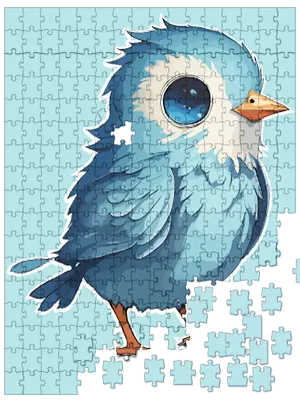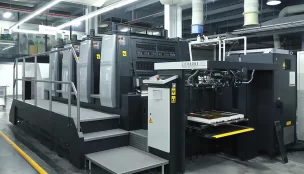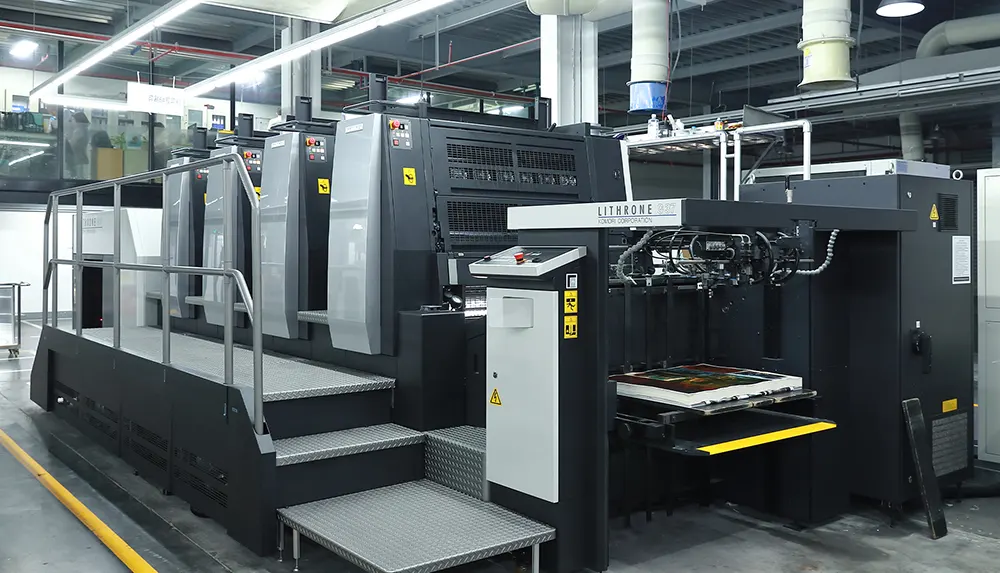As the self-publishing industry matures, more self-publishers are leaving print-on-demand and discovering the benefits of traditional custom book printing. We explore why.
Amazon's eBook exclusive self-publishing platform, KDP (Kindle Direct Publishing) launched in 2007. It was an immediate success. In 2016, they added what was then ‘Create Space'. Create Space — now absorbed into KDP — was a POD (print-on-demand) paperback book printing and distribution service specifically designed to cater to the self-publishing community. Since then, the self-publishing industry has boomed, evolved, and matured.
The self-publishing revolution
According to a recent Bowker report on self-publishing, close to 2 million books are self-published each year in the US alone. While there are signs that the curve is beginning to level off, there's no doubt that the rise of the e-reader and POD book services have changed the face of modern publishing forever. But what's more interesting from our point of view — as a major international custom printing company — is that the lines between self-publishing and traditional publishing are beginning to blur. As successful self-publishers have more capital to invest in their businesses, they're moving away from the POD services and looking to traditional printers to produce superior products while enjoying significant savings and a higher return on their investment.
The truth about POD services
While there's a lot of noise about the ease and cost-efficiency of POD services — largely created by the marketing departments of those services! — contemporary self-publishers are waking up to the better options available to them. If POD was the self-publisher's panacea that's it's often cracked up to be, then mainstream publishing houses would be using it, too, and the offset printing business would have given up the ghost a long time ago. But that's obviously not the case.
POD is a handy starter mode if you've never published anything before, you're new to the industry, you don't have much capital to invest, and you don't yet have a fan base or a significant email list. But as soon as you've started generating regular sales and grown your list, it may be time to up your game. The reason why mainstream publishing houses and savvy, successful self-publishers eschew print-on-demand and invest in custom offset book printing is simple: it's cheaper and you get a superior product.
According to an article by the Science Fiction and Fantasy Writers of America, print-on-demand book sales are dismally low. The vast majority of POD books sell fewer than 200 copies in their lifetime. Whereas an offset printed traditionally published book is more likely to sell an average of 10,000 copies.
The POD share of the market is still very small. Most books are printed by custom offset printers like ourselves. And we know because we publish a lot of books every year for self-publishing clients. The services we offer use skilled designers, printing experts, the highest quality sustainable materials, and the very latest printing technology. And because we are based in China and can print anything from as few as a couple of hundred up to thousands of books in a single run, we can offer extremely competitive pricing all over the world.
What's the difference between POD and offset printing?
But perhaps we're running ahead of ourselves. There are key differences between POD and offset printing to take into account. Let's explain a few of them now.
- Print-on-demand is an automated digital printing method which makes one book at a time, on demand
- Offset printing is a higher-quality traditional printing method which prints hundreds or thousands of copies in a single ‘print run'
- POD books are made from inferior materials — paper stocks, inks, glue bindings, etc. — and cost more per unit than offset printed books
- Offset printed books are made from superior materials and because we can produce thousands of books in a single print run, they're much cheaper per unit, even in a relatively small print run of just a few hundred copies
- POD offers very limited options in terms of size, format, cover type, and finish
- Offset printing offers a universal choice of sizes and formats, materials and finishes, and a custom printer can create a book to your specialist specifications, including children's board books, pop-up books, coffee table books, hardcovers, and more
If offset printing is better, why do so many authors choose POD?
You might wonder, given all the advantages of custom offset printing — cheaper costs per unit, superior quality materials, a wider range of choices — why anyone uses POD at all. There are two clear answers to that, one is historical and one is practical. Let's look at both.
The historical reason why people still choose POD
Prior to the launch of the Amazon self-publishing platform, self-publishing was almost never thought of in most cases. It was really the e-Book which launched the self-publishing boom during the following decade. The POD paperback services were added as an afterthought. But by that time — KDP launched in 2007 and the POD service in 2016 — most self-publishers associated the business of self-publishing with Amazon and its services as the company had instigated and continued to dominate the industry. It wasn't that each author evaluated all the options and made a decision based on the data, it just ‘seemed obvious' to keep all your publishing activities under one roof. Many authors didn't even realize that they could use custom printers!
This assumption is being challenged today. Increasing numbers of self-publishing authors are waking up to the realization that there are other offers out there and that they may have been missing a trick all this time. And as even moderately successful self-publishing authors explore the advantages of offset printing, we see another shift in the industry taking place, allowing authors more creative control over their work and opportunities to increase their profit margins, too.
The practical reason why people still choose POD
We shouldn't really say this as we're in the custom offset printing business, but it would be disingenuous not to admit that POD has its place in the printing and publishing ecology. It's a useful ‘first step' for an author with no following who is completely new to the industry. Why? Because, even though it's actually more expensive, the initial investment is much lower. So, for first-time authors without, as yet, a readership, it's often a very useful way to ‘test the waters'. But once that author has found their niche, published a couple of books that are selling well, established a fan base and developed a responsive email list, it's probably time to switch to offset printing for all the reasons we've explained.
Which self-publishing projects are best suited to offset printing?
Of course, you won't need to strain your research muscles to find plenty of self-publishing authors who are very happy with their current eBook/POD arrangements. We wish them well. But we believe that authors deserve to know the facts, so that they can make informed, knowledgeable decisions. And there are certain kinds of publishing projects which are either better suited to offset printing or simply can't be done with the current limited options POD has to offer.
- Coffee table books — any book with a strong visual element that demands beautiful, high-quality reproductions of artwork, photography, or illustration, which is the case for most coffee table books, needs the flexibility and top-end technology of an offset printing process.
- Specialist and niche books — not all self-publishers are writing zombie apocalypse, military science fiction, spicy romance, crime thrillers, or swords and sorcery stories! If you're publishing travelogues, memoirs, histories, or science, for example, you may find the POD services are too limited. If your book needs inserts, for example, or combines both a significant amount of text and diagrams or photographs in a specific format, again, you'll need a custom printer.
- Children's books and odd-sizes — no POD service can yet offer large formats, board books, or pop-up books. But a good custom printer — hello! — can do all of that and more. We can even work with you to create a completely unique book.
- Guaranteed 500 copies or more — if you have a responsive email list of fans to whom you can directly promote your work, and you know that you can sell at least five hundred copies at a time, then it's a ‘no-brainer' to order an offset print run. It'll save you a small fortune compared to POD.
Top tips for working with a custom offset printer
You should by now realize that the well-known ‘self-publishing services' such as Amazon, Draft2Digital, and IngramSpark — while they may have their place — are by no means the only or best options available to you as you build your self-publishing career. Offset printing may not be right for you, but it's certainly worth exploring before you dismiss it out of hand. Here are a few top tips for working with a custom printer.
- Get your designer and printer onboard at the same time — unless you're a design school graduate with all the relevant software and industry knowledge, you'll need to hire a professional designer to develop your covers and interior formatting. If you choose an independent designer, get them in touch with your printer early in the process. The best printers — ahem, we're blushing — can make life easier for your designer by providing upfront all the necessary information about sizes, trim, bleed, safe zones, color spaces, and all the technical stuff. If appropriate we can also work up a template for your designer to use. And if you choose us as your printer, we also have a team of expert, experienced book designers in-house, which can streamline the whole process and make it cheaper, too.
- Don't confuse an office supplies printer with offset — not all printers are made equal! Certain well-known commercial printers who do a fair job of making flyers, brochures, posters, and business cards, use exclusively digital systems and have neither the knowledge or the technology to create a professional-looking book. So, make sure that you're talking to a custom offset printer and not any other kind.
- Consider going international — the cost of paper is always rising, likewise with ink, and consequently printing costs are going up, too. One way to counter this trend is to go with an international rather than local printer. You may think that a local printer will be cheaper because your books won't be shipped so far. But think again. For example, we're a moderately-sized company with a small but enthusiastic team, but we have high-level expertise. Because we're based in Shanghai, all our costs are lower compared to a similar company in the US or Europe, so that even accounting for shipping, we can probably offer you a better deal.
- Always get a quote — this may seem obvious, but you should always get a quote for the work and make sure it includes all services. Maybe ask a few other companies and compare the price to service to product offers to establish the true value before you write a check.
- Ask about storage — one of the arguments put forward in some quarters against the idea of custom printing is to ask where you'll store all those books? But the best custom printers also offer storage and shipping solutions tailored to the needs of self-publishers. For example, we know that most of our clients don't own a warehouse! We offer a year's storage and we'll happily ship your books to you as you need them — even singly.
The bottom line
We hope that's been helpful to you — and possibly even enlightening. So, the bottom line is that since its birth in the early 2000s, the self-publishing industry has grown up and matured. More self-publishers now than ever before are running their businesses at a very professional level. Increasing numbers of successful independents are turning to traditional custom offset services to fulfill their printing requirements because they're discovering that they can get a better product at a cheaper price. And what's not to love about that?
If you have a project in mind or you'd just like to chat through the options in more detail, get in touch. We're truly passionate about printing and we have decades of experience helping authors just like you to realize their dreams. Call for a chat, drop us a line, or ask for a quote. There's no obligation on your part. We'd be happy to help.









Do you know of any distributors that will store off-set books and ship out to book stores? This has been my biggest obstacle with having of set books
Hi Erika,
Thank you for reaching out!
While our company focuses on printing, We can suggest some popular distributors include Ingram Content Group and Baker & Taylor. These distributors often offer services that can help with storage, order fulfillment, and distribution to various retailers.
We haven't collaborated with these distributors, so I'm unable to vouch for their services. I'd recommend reaching out to them directly to discuss your specific requirements.
Should you need any further assistance or have more questions, please feel free to ask.